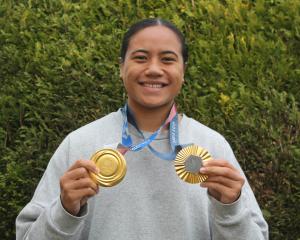
All three New Zealand athletes knew what was ahead of them during the qualification round on a warm Monday morning in Paris.
The qualification standard was set at 4.70 metres. Two pole vault pits would be running side by side and at least the top 12 best performed athletes would be through the the final two days later.
All was going to plan until the bar was lifted to 4.55m.
Olivia McTaggart was the first of the New Zealanders to compete. She cleared the first height of 4.20m comfortably, likewise the second of 4.40m.
It was a similar tale for Imogen Ayris, who was competing in the second group with McCartney. Ayris ticked off 4.20m - a height that McCartney opted to skip - and was also clear on her first attempt at 4.40m.
"I'm really happy with how I was jumping today 4.20, 4.40 couldn't have asked for much more a clean competition, big jumps, rolling poles," Ayris said.
However, 4.55m proved to be "sticky" for the New Zealand trio as well as many others in the 32-strong field.
All three Kiwis missed on their first attempt at 4.55m.
McCartney nailed it on her second attempt, but McTaggart and Ayris couldn't clear it in their three attempts.
On a particularly tough day in the pit, McCartney was one of only 11 athletes who successfully cleared 4.55 metres - meaning that height became the automatic qualification point even though it was 15 centimetres below what was set out before the competition started.
With the last spot to fill in the final, the Olympic organisers determined that all nine remaining athletes who cleared 4.40m on their first attempt would be through.
The Olympic final will now be contested between 20 athletes rather than the traditional 12.
Cue mixed emotions for the New Zealanders.
"I started to do the maths at one point but I knew it was going to come down to a really fine margin," Ayris said of the wait to see if she'd make the top 12.
In the chaos and confusion after the last competitor had failed at 4.55m Ayris didn't know what it meant for her and McTaggart.
"But when I looked up into the stands and I saw my coach standing with his arms in the air I was like 'okay we've done it'."
McTaggart who has a personal best of 4.71m believes she's lucky to be in the final.
"I didn't feel like I was jumping my best, I feel like I was tentatively jumping so I was still a little bit disappointed in how I was jumping and I did not think that that would make the final but it did," McTaggart said.
"I'm going to put absolutely everything into that final I've got that opportunity and I'm going to do everything I can to squeeze everything out of it.
"I do feel like I have a lot more in me I just need to commit more to my jumps and actually get upside down those jumps weren't really how I normally would [jump] so it feels like a little bit of luck [to make finals]."
Conversely, McCartney, a bronze medallist at the 2016 Rio Olympics, was pleased with her qualification jumps - even if the session ended sooner than she expected.
"I was really happy with how my body was feeling, I felt really in control and I think I made some good decisions out there," McCartney said.
"It was a good chance to get some jumps done as a warm up. We got only two heights and I was definitely expecting to need to jump 4.70 but a short qualifier is probably better [so] we can just save ourselves and be ready for a final."
The final will be unlike anything the New Zealanders have ever done.
"I've never jumped with 20 girls on one pit even in qualification having 16 girls feels like a lot," Ayris said.
"There are going to be some new challenges that we've never faced before they were even talking to us about moving competition times forwards changing call room times just to adapt to the situation with that many girls because the competition is not prepared for 20 girls in the final."
But the New Zealand pole vaulters are prepared for the final and for McTaggart and Ayris to make the most of their second chance.













